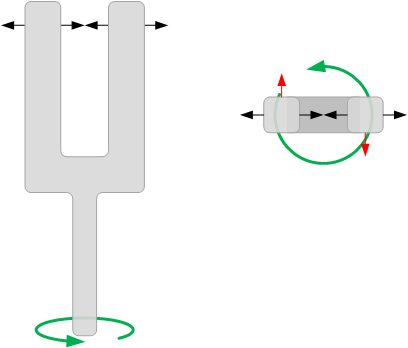
[From the last episode: Measuring rotation acceleration tells you something about your orientationThe direction someone or something is facing. This may be different from the direction of motion., and it’s a natural complement to measuring acceleration in a straight line.]
If you’ve ever held onto the two mounting screws in the hub of a bicycle tire while a friend spun the wheels, then you’re half-way to knowing how a gyroscope works. When the wheel spins fast, it becomes really hard to change its orientation – it feels like it fights your attempts to make change. Which kind of makes sense – it’s why you can ride a bike on those two narrow wheels and not fall over.
What you feel in that case is what seems like a force working against you. If you’ve held that wheel while sitting on a spinning chair, you may even notice that changing the rotation angle of the tire means you yourself will start spinning on the chair.
In fact, what you’re feeling is not truly a force – it’s just inertiaThe tendency for an object to keep moving (or not moving) at a constant speed if you don’t accelerate or decelerate it. There’s inertia in a straight line and there’s also inertia of rotation – spinning things want to keep rotating in a specific direction unless you force them to change.. It takes work to change the rotation, just like it takes work to make a locomotive go faster in a straight line. Traditional gyroscopes have taken advantage of this to help mariners get safely to port and for airplanes to land at the right airport for many years. But how to do this at a micro scale?
Calling Coriolis
True rotating gyroscopesA sensor that detects when it changes direction. are still the most precise, but there’s another natural phenomenon that we can take advantage of. Often called the Coriolis force, it’s more accurately called the Coriolis effect because it’s not really a force; it just looks like one (like centrifugal “force” does).
The Coriolis effect is easy to imagine if you think of the earth spinning. Let’s say you throw a ball straight up into the air. Well, actually, let’s say we were on a planet with no atmosphere – so there’s no air to rotate with the earth. So now you throw the ball up. Where will it land? (Yes, I understand that you’re having a hard time breathing with no oxygen and the fact that your body has exploded due to the vacuum, but work with me here…)
If you were able to throw it up perfectly straight, then you’d think that the ball would land right back at the position where you threw it. But if you throw it really, really high, and if the planet’s rotation is pretty fast, then you might notice that the ball looks like it lands away from where it started. Why is that?
It’s because, while the ball was in the air, the ground was moving underneath it (and there’s no air to carry the ball with the ground). So the ball comes truly straight back down – but lands in the spot that moved under the ball.
Tuning Up
The only way you can experience the Coriolis effect is if you’re moving. So that’s what MEMS designers do: they make the proof mass move – by making it vibrate. For instance, they may take a tuning-fork shape and set it resonating. Now the two tines of the fork are moving back and forth towards each other and away from each other.
As it turns out, if you picture this tuning fork sitting vertically, with tines in the air and parallel with this pageA chunk of memory on a hard drive or SSD that can be brought into DRAM for use or for execution., then, if you spin it about the handle, you’ll get what looks like a force pushing one tine in one direction and the other tine in the opposite direction. And, just like with the accelerometerA sensor that measures acceleration and deceleration., we can use capacitance to measure that movement.

Gyroscope Gotchas
There are two important things about MEMS gyroscopes. The first is that you need to set something vibrating (or otherwise moving). That takes energy; it’s different from an accelerometer, which just sits there. So if the gyroscope is on in your phone, it’s quietly draining the battery, whether you’re making use of it or not.
In some cases, the accelerometer can help with this. The gyroscope can be in standby mode – on, but not actually vibrating. If the accelerometer detects some movement, then it quickly turns on the gyroscope. That can save a ton of energy.
The other important thing about MEMS gyroscopes is that, for your everyday version, it’s not as accurate as an old-school macro gyroscope. Each time you turn, it makes a small error. The next time you turn, it makes another small error. If you were facing forwards and then turned left and right a bunch of times, each time returning to forward, the gyroscope is going to accumulate errors and eventually think you’re not facing forward anymore.
SensorA device that can measure something about its environment. Examples are movement, light, color, moisture, pressure, and many more. makers have worked hard to improve this, and they’ve been successful in making it better. But the ones in your phone are still nowhere close to “navigation grade.” You pay beaucoups bucks for those – many times over what your entire phone would cost. But it’s good enough for what we need. Mostly.

Leave a Reply